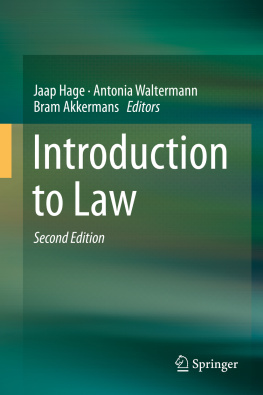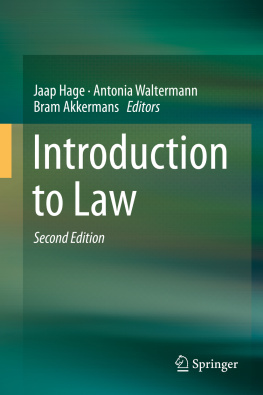What Is Law?
The main question that any introduction to law must answer deals with the nature of law. Although the need for the characterization of the nature of law is obvious, it is a need that is not easily satisfied. The law is multifaceted, and arguably has been in flux over the centuries. In this current age of globalization and Europeanization, it is changing at such a high speed that it is impossible to give a short definition of law from the outset. What is possible, however, is to mention a few characteristics of law. The majority of legal phenomena share most of these characteristics, but not all legal phenomena share all of them.
Rules
A substantial part of law exists in the form of rules. These rules do not only specify how people should behave (Do not steal, Everybody with an income must pay income tax), but they also contain definitions of terms, create competencies, and much more.
An example of a rule that gives a definition of a term can be found in Article 1 of the International Convention on the Elimination of All Forms of Racial Discrimination, which defines racial discrimination as
any distinction, exclusion, restriction or preference based on race, color, descent, or national or ethnic origin which has the purpose or effect of nullifying or impairing the recognition, enjoyment or exercise, on an equal footing, of human rights and fundamental freedoms in the political, economic, social, cultural or any other field of public life.
Article 37, Section 1 of the International Covenant on Civil and Political Rights provides an example of a rule that creates a competency for the Secretary-General of the United Nations. It states, in connection with the Human Rights Committee:
The Secretary-General of the United Nations shall convene the initial meeting of the Committee at the Headquarters of the United Nations.
Society is governed not only by legal rules but also by other types of rules. In the next section, we will have a closer look at the laws most important relative morality and moral rules but there are also other types of rules, such as the rules that belong to:
A religion (e.g., the Ten Commandments)
Etiquette (e.g., Eat with a knife and fork)
Special organizations such as student associations (e.g., Every member must perform bar service twice a month)
Collective enforcement
Legal rules are normally enforced by collective means and in particular by organs of the State, while other rules typically are not. Moreover, legal rules have very specific sanctions, such as incarceration, fines, compensation of damage, etc., while the sanctions of non-legal rules are less specific. For instance, someone who has committed a crime and broken a legal rule is liable to be punished by State organs such as the police and the prosecution service. However, from a moral point of view it is wrong to lie. While liars may be liable to informal and private sanctions such as reproach and avoidance, they will seldom be sanctioned by collective means.
Positive law
At present, most laws are explicitly created by means of legislation or judicial decisions. These laws are called positive law. The word positive in this connection is derived from the Latin positus , which literally means laid down. The idea that law is explicitly created seems so obvious that the expression positive law has almost become synonymous with the law that is valid here and now. However, the increasing importance of non-State rules is a reason to question this obviousness.
Legal certainty
It is often easy to establish the contents of positive law. The rules only need to be looked up in legislation or in judicial decisions. This may take some time, but in the end, it is often possible to establish the contents of the law beyond a reasonable doubt: positive law offers legal certainty . Therefore, it is usually unnecessary to invoke an authority such as a judge to settle a legal dispute. The parties can predict what the judges decision would be, and in that way save both them and society at large, time and money.
If the issue at stake is not what the positive law is, but rather what is really right, it may be much harder to reach an agreement. People often disagree about what is right or wrong. This predicament creates less favorable conditions for a smooth functioning society than the certainty of positive law. Often it is better to have no conflicts or fast solutions for conflicts, than to have a laboriously reached right solution. Therefore, law often prefers the certainty of a clear result over the uncertainty of the best solution for a problem.
Positive law also offers legal certainty in a different manner, namely by providing collective support for the enforcement of legal duties. If people are left to their own devices when it comes to enforcing their rights, this decreases the certainty that the rights will be respected.
A third aspect of legal certainty is that similar cases are treated in a similar fashion or in other words that the law will be applied consistently. For instance, if one citizen is granted a building permit, legal certainty requires that another citizen in exactly the same position should also be granted a building permit.
So legal certainty has at least three aspects:
Certainty about the content of the law
Certainty that the law will be enforced
Certainty that the law will be applied consistently
Roman Law
Our present-day law did not fall out of the blue sky; it is rather the outcome of a historical development in which the sources of law play an important role. As the easiest way to obtain an understanding of legal sources is through history, we will sketch the development of the law in Europe through time. In this examination, Roman law and common law play a central role.
Historical descriptions of the development of law in Europe often start with the impressive legal system built by the Romans in the period ranging from the eighth century BCE (Before Common Era) until the sixth century CE (Common Era). Impressive as the Roman system may have become over the course of these centuries, it started out in a simple form: tribal customary law.
2.1 Tribal Customary Law
Nowadays, we are very much accustomed to the idea of law as being the law of a particular country, such as German law or English law. More recently, we have seen the emergence of European law existing concurrently with national laws in the countries that make up the European Union. Moreover, for a number of centuries, a body of law has existed that governs the relations between States. This body is called public international law.
However, the law of the Romans was not the law of a country or a State, but the law of a people , namely the Roman people. Since they were comprised of a tribal group whose members were connected mostly by family ties, the early law of the Romans was tribal law .
It is also possible to have law that is not connected to a particular territory or a particular people, but to a particular religion. Examples are Talmudic law, attached to the Jewish religion, and Sharia law, attached to the Islam.
As a people grows larger, the main ties between its members can no longer be family ties, or at least not close family ties. The binding factor will then be a shared culture, for instance based on a common religion or language. We call such a people with a shared culture a nation.












